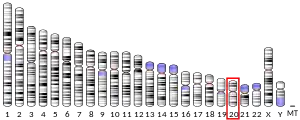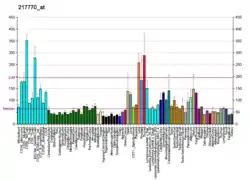PIGT
GPI transamidase component PIG-T is an enzyme that in humans is encoded by the PIGT gene.[5][6][7]
| PIGT | |||||||||||||||||||||||||||||||||||||||||||||||||||
|---|---|---|---|---|---|---|---|---|---|---|---|---|---|---|---|---|---|---|---|---|---|---|---|---|---|---|---|---|---|---|---|---|---|---|---|---|---|---|---|---|---|---|---|---|---|---|---|---|---|---|---|
| Identifiers | |||||||||||||||||||||||||||||||||||||||||||||||||||
| Aliases | PIGT, MCAHS3, NDAP, PNH2, CGI-06, phosphatidylinositol glycan anchor biosynthesis class T | ||||||||||||||||||||||||||||||||||||||||||||||||||
| External IDs | OMIM: 610272 MGI: 1926178 HomoloGene: 6134 GeneCards: PIGT | ||||||||||||||||||||||||||||||||||||||||||||||||||
| |||||||||||||||||||||||||||||||||||||||||||||||||||
| |||||||||||||||||||||||||||||||||||||||||||||||||||
| |||||||||||||||||||||||||||||||||||||||||||||||||||
| |||||||||||||||||||||||||||||||||||||||||||||||||||
| |||||||||||||||||||||||||||||||||||||||||||||||||||
| Wikidata | |||||||||||||||||||||||||||||||||||||||||||||||||||
| |||||||||||||||||||||||||||||||||||||||||||||||||||
This gene encodes a protein that is involved in glycosylphosphatidylinositol (GPI)-anchor biosynthesis. The GPI-anchor is a glycolipid found on many blood cells and serves to anchor proteins to the cell surface. This protein is an essential component of the multisubunit enzyme, GPI transamidase. GPI transamidase mediates GPI anchoring in the endoplasmic reticulum, by catalyzing the transfer of fully assembled GPI units to proteins.[6]
References
- GRCh38: Ensembl release 89: ENSG00000124155 - Ensembl, May 2017
- GRCm38: Ensembl release 89: ENSMUSG00000017721 - Ensembl, May 2017
- "Human PubMed Reference:". National Center for Biotechnology Information, U.S. National Library of Medicine.
- "Mouse PubMed Reference:". National Center for Biotechnology Information, U.S. National Library of Medicine.
- Vainauskas S, Menon AK (Apr 2005). "Endoplasmic reticulum localization of Gaa1 and PIG-T, subunits of the glycosylphosphatidylinositol transamidase complex". J Biol Chem. 280 (16): 16402–9. doi:10.1074/jbc.M414253200. PMID 15713669.
- "Entrez Gene: PIGT phosphatidylinositol glycan anchor biosynthesis, class T".
- Ohishi K, Inoue N, Kinoshita T (August 2001). "PIG-S and PIG-T, essential for GPI anchor attachment to proteins, form a complex with GAA1 and GPI8". EMBO J. 20 (15): 4088–98. doi:10.1093/emboj/20.15.4088. PMC 149153. PMID 11483512.
- Ohishi, Kazuhito; Nagamune Kisaburo; Maeda Yusuke; Kinoshita Taroh (Apr 2003). "Two subunits of glycosylphosphatidylinositol transamidase, GPI8 and PIG-T, form a functionally important intermolecular disulfide bridge". J. Biol. Chem. 278 (16): 13959–67. doi:10.1074/jbc.M300586200. ISSN 0021-9258. PMID 12582175.
- Vainauskas, Saulius; Maeda Yusuke; Kurniawan Henry; Kinoshita Taroh; Menon Anant K (Aug 2002). "Structural requirements for the recruitment of Gaa1 into a functional glycosylphosphatidylinositol transamidase complex". J. Biol. Chem. 277 (34): 30535–42. doi:10.1074/jbc.M205402200. ISSN 0021-9258. PMID 12052837.
Further reading
- Eisenhaber B, Maurer-Stroh S, Novatchkova M, et al. (2003). "Enzymes and auxiliary factors for GPI lipid anchor biosynthesis and post-translational transfer to proteins". BioEssays. 25 (4): 367–85. doi:10.1002/bies.10254. PMID 12655644.
- Maruyama K, Sugano S (1994). "Oligo-capping: a simple method to replace the cap structure of eukaryotic mRNAs with oligoribonucleotides". Gene. 138 (1–2): 171–4. doi:10.1016/0378-1119(94)90802-8. PMID 8125298.
- Suzuki Y, Yoshitomo-Nakagawa K, Maruyama K, et al. (1997). "Construction and characterization of a full length-enriched and a 5'-end-enriched cDNA library". Gene. 200 (1–2): 149–56. doi:10.1016/S0378-1119(97)00411-3. PMID 9373149.
- Lai CH, Chou CY, Ch'ang LY, et al. (2000). "Identification of novel human genes evolutionarily conserved in Caenorhabditis elegans by comparative proteomics". Genome Res. 10 (5): 703–13. doi:10.1101/gr.10.5.703. PMC 310876. PMID 10810093.
- Ohishi K, Inoue N, Kinoshita T (2001). "PIG-S and PIG-T, essential for GPI anchor attachment to proteins, form a complex with GAA1 and GPI8". EMBO J. 20 (15): 4088–98. doi:10.1093/emboj/20.15.4088. PMC 149153. PMID 11483512.
- Yu Y, Zhang C, Zhou G, et al. (2001). "Gene expression profiling in human fetal liver and identification of tissue- and developmental-stage-specific genes through compiled expression profiles and efficient cloning of full-length cDNAs". Genome Res. 11 (8): 1392–403. doi:10.1101/gr.175501. PMC 311073. PMID 11483580.
- Fossey SC, Mychaleckyj JC, Pendleton JK, et al. (2001). "A high-resolution 6.0-megabase transcript map of the type 2 diabetes susceptibility region on human chromosome 20". Genomics. 76 (1–3): 45–57. doi:10.1006/geno.2001.6584. PMID 11549316.
- Deloukas P, Matthews LH, Ashurst J, et al. (2002). "The DNA sequence and comparative analysis of human chromosome 20". Nature. 414 (6866): 865–71. Bibcode:2001Natur.414..865D. doi:10.1038/414865a. PMID 11780052.
- Vainauskas S, Maeda Y, Kurniawan H, et al. (2002). "Structural requirements for the recruitment of Gaa1 into a functional glycosylphosphatidylinositol transamidase complex". J. Biol. Chem. 277 (34): 30535–42. doi:10.1074/jbc.M205402200. PMID 12052837.
- Strausberg RL, Feingold EA, Grouse LH, et al. (2003). "Generation and initial analysis of more than 15,000 full-length human and mouse cDNA sequences". Proc. Natl. Acad. Sci. U.S.A. 99 (26): 16899–903. Bibcode:2002PNAS...9916899M. doi:10.1073/pnas.242603899. PMC 139241. PMID 12477932.
- Ohishi K, Nagamune K, Maeda Y, Kinoshita T (2003). "Two subunits of glycosylphosphatidylinositol transamidase, GPI8 and PIG-T, form a functionally important intermolecular disulfide bridge". J. Biol. Chem. 278 (16): 13959–67. doi:10.1074/jbc.M300586200. PMID 12582175.
- Hong Y, Ohishi K, Kang JY, et al. (2004). "Human PIG-U and yeast Cdc91p are the fifth subunit of GPI transamidase that attaches GPI-anchors to proteins". Mol. Biol. Cell. 14 (5): 1780–9. doi:10.1091/mbc.E02-12-0794. PMC 165076. PMID 12802054.
- Clark HF, Gurney AL, Abaya E, et al. (2003). "The secreted protein discovery initiative (SPDI), a large-scale effort to identify novel human secreted and transmembrane proteins: a bioinformatics assessment". Genome Res. 13 (10): 2265–70. doi:10.1101/gr.1293003. PMC 403697. PMID 12975309.
- Gerhard DS, Wagner L, Feingold EA, et al. (2004). "The status, quality, and expansion of the NIH full-length cDNA project: the Mammalian Gene Collection (MGC)". Genome Res. 14 (10B): 2121–7. doi:10.1101/gr.2596504. PMC 528928. PMID 15489334.
- Otsuki T, Ota T, Nishikawa T, et al. (2007). "Signal sequence and keyword trap in silico for selection of full-length human cDNAs encoding secretion or membrane proteins from oligo-capped cDNA libraries". DNA Res. 12 (2): 117–26. doi:10.1093/dnares/12.2.117. PMID 16303743.
- Kimura K, Wakamatsu A, Suzuki Y, et al. (2006). "Diversification of transcriptional modulation: large-scale identification and characterization of putative alternative promoters of human genes". Genome Res. 16 (1): 55–65. doi:10.1101/gr.4039406. PMC 1356129. PMID 16344560.
- Li HL, Li Z, Qin LY, et al. (2006). "The novel neurotrophin-regulated neuronal development-associated protein, NDAP, mediates apoptosis". FEBS Lett. 580 (7): 1723–8. doi:10.1016/j.febslet.2006.02.022. PMID 16516892. S2CID 1016691.
This article is issued from Wikipedia. The text is licensed under Creative Commons - Attribution - Sharealike. Additional terms may apply for the media files.




